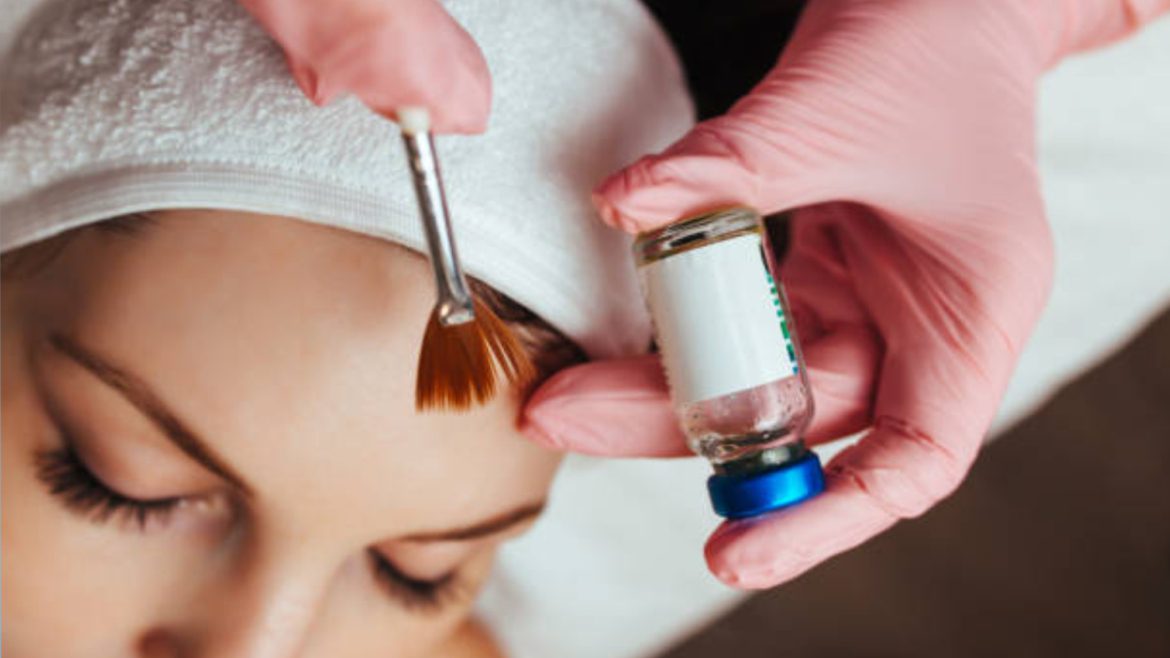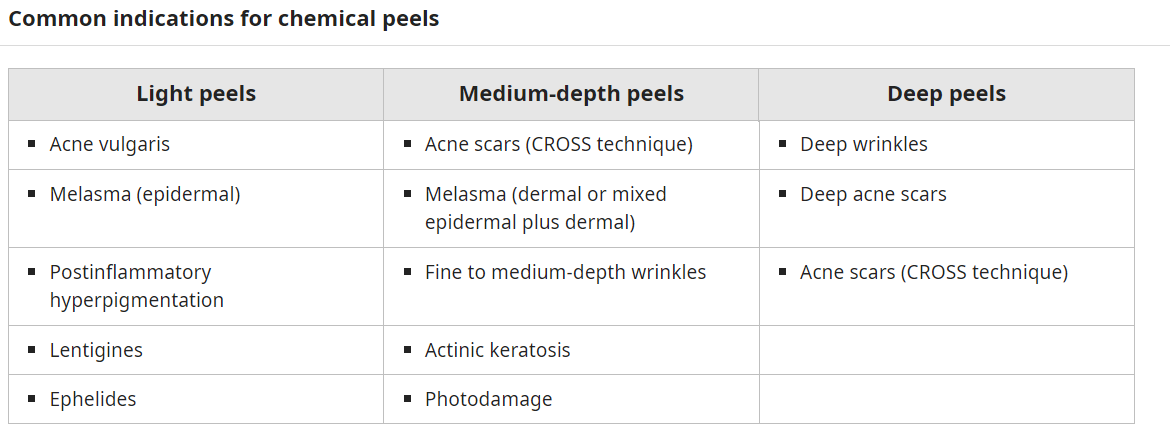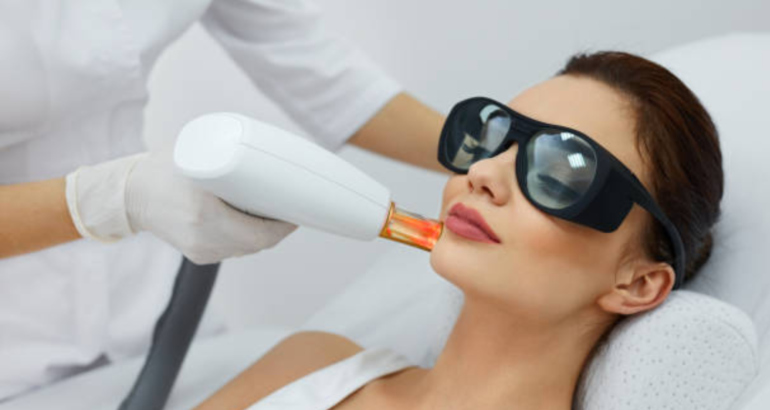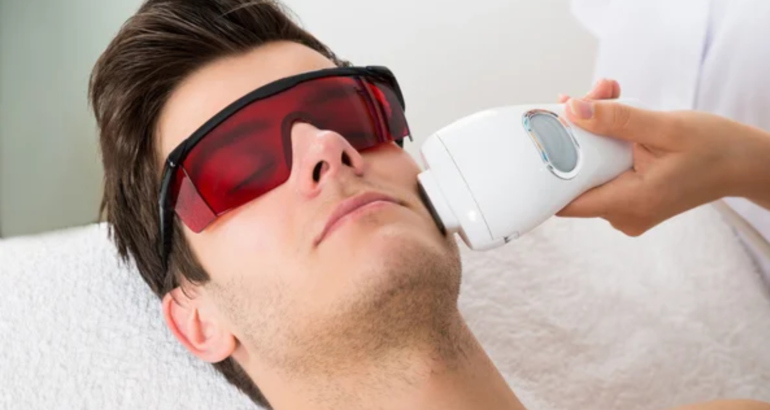
Chemical Peel
A chemical peel is a procedure in which a chemical solution is applied to the skin to remove the top layers. It is used to treat wrinkles, discolored skin, and scars. It can be of various depths.
Benefits of Chemical Peel
A chemical peel can help improve skin quality, texture, and appearance. This process includes using a substance that can cause controlled injury to the skin, resulting in skin healing and reducing problems like hyperpigmentation, rhytides, acne scars, actinic keratoses, and others. The chemical peels contain Glycolic acid, Salicylic acid, Mandelic acid, Lactic acid, Resorcinol, Pyruvic acid, and Retinoic acid.
Chemical peels are usually performed on the head and neck. These fast procedures can also treat photodamage on the arms, chest, and sometimes legs.
You can choose to have the treatment done on your whole face or just a portion. Many chemical peel options allow you to control the level of resurfacing for your skin and choose the best option for your specific needs. The depth of skin injury a chemical peel induces is the major determinant of the effect of the treatment.
Light chemical peels (superficial chemical peels) cause injury limited to the epidermis and are primarily used for cutaneous hyperpigmentation and mild improvements in skin texture and acne. Medium-depth peels injure the epidermis and papillary dermis, improving features such as hyperpigmentation, actinic keratoses, superficial acne scars, and shallow wrinkles.
If you have deep acne scars or wrinkles, a deep peel may help. This type of peel goes beyond the surface layer of your skin into the deeper layer called the reticular dermis. The depth of the peel depends on the type of peeling agent used and how it is applied.
Who should not consider doing this treatment?
Before beginning treatment, the doctor will assess the patient for potential risks and negative effects. These could include trouble following skin care instructions, ongoing infections, medications that weaken the immune system, and body dysmorphic disorder. This disorder may increase the likelihood of feeling dissatisfied with the expected outcome. Below are a few conditions which might warrant extra precaution if we go ahead with chemical peel:
- Dyspigmentation risk: People with darker skin (Fitzpatrick skin phototypes III to VI) are more likely to experience post-treatment pigmentation changes (PIH) and permanent lightening after chemical peels. Those who fall into this category and choose to undergo light, medium-depth, or deep peels must be properly informed about the risks associated with the treatment.
It is important to explain to them the possibility of PIH and the importance of adhering to pre- and post-treatment measures designed to decrease the risk of PIH. PIH is typically a temporary issue that can be addressed with topical therapies and light peels. Still, hypopigmentation is typically the result of the depth of peeling and is usually permanent.
- Wound healing disorder: A medium-depth or deep chemical peel should be discussed with a doctor for patients with trouble healing. These peels should not be done on patients with malnutrition or severe protein deficiency. There are also other things to consider, like smoking (tobacco, marijuana, electronic cigarettes, e-cigarettes), a history of radiation therapy in the treated area, and certain medications (like systemic glucocorticoids) or diseases that can make healing harder, making it an important point to be discussed with a doctor.
- Hypertrophic or keloidal scarring history: If a patient has had hypertrophic or keloidal scarring, they may be more likely to experience the same type of scarring after getting medium-depth or deep chemical peels. We strongly recommend that people who have had keloidal scarring on their face in the past avoid getting medium-depth or deep facial chemical peels. If they have had hypertrophic or keloidal scarring elsewhere on their body, medium-depth or deep facial chemical peels are still an option, but careful consideration is necessary.
- Isotretinoin therapy: Chemical peels should be avoided for at least 6 to 12 months following Isotretinoin therapy because of concern for increased risk for poor wound healing and scarring. We usually avoid giving chemical peels during the Isotretinoin therapy because the dryness and peeling of the skin caused by isotretinoin can lead to uneven absorption of the peel solution. However, we can do the peels once the treatment is complete. It is recommended to avoid undergoing medium-depth or deep chemical peels for at least three to four months after using isotretinoin.
- Rosacea, eczema, and acne vulgaris: If you’re considering a medium-depth or deep chemical peel, it’s important to know that certain conditions may make you ineligible. These conditions include skin inflammation due to rosacea, eczema, or acne vulgaris in the treated area. Additionally, if you have skin disorders that exhibit the Koebner phenomenon (new lesion formation at sites of skin trauma), chemical peels could worsen these conditions. Examples of disorders that may exhibit the Koebner phenomenon include flat warts, lichen planus, psoriasis, and vitiligo.
- Pregnancy and lactation: During pregnancy, it’s best to avoid medium-depth and deep chemical peels since they are usually optional procedures. Additionally, there is not enough information to confirm their safety during pregnancy.
Can I get the medium or deep peel on areas other than the face, like the Neck, Chest, and hands?
Chemical peels can have different effects on different body parts. The face is less likely to scar than the neck, chest, and dorsal hands because those areas lack the necessary structures to support healing. It’s best to avoid medium-depth or deep peels in these areas and stick to light peels instead.
What results can I expect post-treatment?


Where can I see the prices and book an appointment?
You can visit this page to check prices and book an appointment.
Carbon Laser Peel
Carbon Laser peel is a popular anti-aging technique that can enhance collagen production, tighten skin, and reduce wrinkles while improving acne. To clean out pores and eliminate impurities, a charcoal mask is applied and then removed with a 1064 nm laser.
This process removes dead skin cells and excess oil, producing smooth, clear skin with smaller pores. During the process, a thick carbon layer is applied to the patient’s face or treatment area. Then a 1064 nm laser is used to remove the carbon from the face, which in turn removes the top layer of the skin, giving the patient a feel of rejuvenated baby skin. Once all the carbon is removed, we cleanse the face with Zo cleanser and apply ZO sunscreen to protect the new skin from sun damage.




